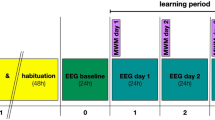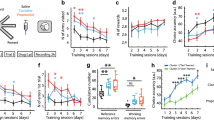Abstract
Several efforts have been made to understand the involvement of rapid eye movement (REM) sleep for cognitive processes. Consolidation or retention of recognition memories is severely disrupted by REM sleep deprivation (REMSD). In this regard, pedunculopontine tegmental nucleus (PPT) and other brainstem nuclei, such as pontine nucleus (Pn) and oculomotor nucleus (OCM), appear to be candidates to take part in this REM sleep circuitry with potential involvement in cognition. Therefore, the objective of this study was to investigate a possible association between the performance of Wistar rats in a declarative memory and PPT, Pn, and OCM activities after different periods of REMSD. We examined c-Fos and choline acetyltransferase (ChaT) expressions as indicators of neuronal activity as well as a familiarity-based memory test. The animals were distributed in groups: control, REMSD, and sleep rebound (REB). At the end of the different REMSD (24, 48, 72, and 96 h) and REB (24 h) time points, the rats were immediately tested in the object recognition test and then the brains were collected. Results indicated that OCM neurons presented an increased activity, due to ChaT-labeling associated with REMSD that negatively correlated (r = −0.32) with the cognitive performance. This suggests the existence of a cholinergic compensatory mechanism within the OCM during REMSD. We also showed that 24 h of REMSD impacted similarly in memory, compared to longer periods of REMSD. These data extend the notion that REM sleep is influenced by areas other than PPT, i.e., Pn and OCM, which could be key players in both sleep processes and cognition.






Similar content being viewed by others
Abbreviations
- ChaT:
-
Choline acetyltransferase
- DI:
-
Discrimination index
- OCM:
-
Oculomotor nucleus
- PD:
-
Parkinson’s disease
- PPT:
-
Pedunculopontine tegmental nucleus
- Pn:
-
Pontine nucleus
- REM:
-
Rapid eye movement
- REMSD:
-
REM sleep deprivation
- REB:
-
Rebound
References
Ribeiro S, Nicolelis MA (2004) Reverberation, storage, and postsynaptic propagation of memories during sleep. Learn Mem 11(6):686–696
Stickgold R (2013) Parsing the role of sleep in memory processing. Curr Opin Neurobiol 23(5):847–853
Louie K, Wilson MA (2001) Temporally structured replay of awake hippocampal ensemble activity during rapid eye movement sleep. Neuron 29(1):145–156
Dos Santos AC, Castro MA, Jose EA, Delattre AM, Dombrowski PA, Da Cunha C, Ferraz AC, Lima MM (2013) REM sleep deprivation generates cognitive and neurochemical disruptions in the intranigral rotenone model of Parkinson’s disease. J Neurosci Res 91:1508–1516
Proenca MB, Dombrowski PA, Da Cunha C, Fischer L, Ferraz AC, Lima MM (2014) Dopaminergic D2 receptor is a key player in the substantia nigra pars compacta neuronal activation mediated by REM sleep deprivation. Neuropharmacology 76(Pt A):118–126
Morris RG (2001) Episodic-like memory in animals: psychological criteria, neural mechanisms and the value of episodic-like tasks to investigate animal models of neurodegenerative disease. Philos Trans R Soc Lond Ser B Biol Sci 356(1413):1453–1465
Dere E, Silva MA, Huston JP (2004) Higher order memories for objects encountered in different spatio-temporal contexts in mice: evidence for episodic memory. Rev Neurosci 15(4):231–240
Souchay C, Isingrini M, Gil R (2006) Metamemory monitoring and Parkinson’s disease. J Clin Exp Neuropsychol 28(4):618–630
McCarley RW (2007) Neurobiology of REM and NREM sleep. Sleep Med 8(4):302–330
Van Dort CJ, Zachs DP, Kenny JD, Zheng S, Goldblum RR, Gelwan NA, Ramos DM, Nolan MA, Wang K, Weng FJ, Lin Y, Wilson MA, Brown EN (2015) Optogenetic activation of cholinergic neurons in the PPT or LDT induces REM sleep. Proc Natl Acad Sci U S A 112(2):584–589
Sakai K, Koyama Y (1996) Are there cholinergic and non-cholinergic paradoxical sleep-on neurones in the pons? Neuroreport 7(15–17):2449–2453
Lima MM (2013) Sleep disturbances in Parkinson’s disease: the contribution of dopamine in REM sleep regulation. Sleep Med Rev 17(5):367–375
Nieto-Gonzalez JL, Carrascal L, Nunez-Abades P, Torres B (2009) Muscarinic modulation of recruitment threshold and firing rate in rat oculomotor nucleus motoneurons. J Neurophysiol 101(1):100–111
Garzon M, De Andres I, Reinoso-Suarez F (1998) Sleep patterns after carbachol delivery in the ventral oral pontine tegmentum of the cat. Neuroscience 83(4):1137–1144
Reinoso-Suarez F, De Andres I, Rodrigo-Angulo ML, Rodriguez-Veiga E (1994) Location and anatomical connections of a paradoxical sleep induction site in the cat ventral pontine tegmentum. Eur J Neurosci 6(12):1829–1836
Fung SJ, Yamuy J, Xi MC, Engelhardt JK, Morales FR, Chase MH (2000) Changes in electrophysiological properties of cat hypoglossal motoneurons during carbachol-induced motor inhibition. Brain Res 885(2):262–272
Pinto L, Goard MJ, Estandian D, Xu M, Kwan AC, Lee SH, Harrison TC, Feng G, Dan Y (2013) Fast modulation of visual perception by basal forebrain cholinergic neurons. Nat Neurosci 16(12):1857–1863
Fu Y, Tucciarone JM, Espinosa JS, Sheng N, Darcy DP, Nicoll RA, Huang ZJ, Stryker MP (2014) A cortical circuit for gain control by behavioral state. Cell 156(6):1139–1152
Harrison TC, Pinto L, Brock JR, Dan Y (2016) Calcium imaging of basal forebrain activity during innate and learned behaviors. Front Neural Circ 10:36
Lima MMS, Andersen ML, Reksidler AB, Silva A, Zager A, Zanata SM, Vital MA, Tufik S (2008) Blockage of dopaminergic D(2) receptors produces decrease of REM but not of slow wave sleep in rats after REM sleep deprivation. Behav Brain Res 188(2):406–411
Machado RB, Hipolide DC, Benedito-Silva AA, Tufik S (2004) Sleep deprivation induced by the modified multiple platform technique: quantification of sleep loss and recovery. Brain Res 1004(1–2):45–51
Ennaceur A, Delacour J (1988) A new one-trial test for neurobiological studies of memory in rats. 1: behavioral data. Behav Brain Res 31(1):47–59
Ennaceur A, Michalikova S, Bradford A, Ahmed S (2005) Detailed analysis of the behavior of Lister and Wistar rats in anxiety, object recognition and object location tasks. Behav Brain Res 159(2):247–266
Paxinos G, Watson C (2005) The rat brain in stereotaxic coordinates, 5th edn. Academic Press, San Diego
Erro R, Santangelo G, Picillo M, Vitale C, Amboni M, Longo K, Costagliola A, Pellecchia MT, Allocca R, De Rosa A, De Michele G, Santoro L, Barone P (2012) Link between non-motor symptoms and cognitive dysfunctions in de novo, drug-naive PD patients. J Neurol 259(9):1808–1813
Rodrigues LS, Targa AD, Noseda AC, Aurich MF, Da Cunha C, Lima MM (2014) Olfactory impairment in the rotenone model of Parkinson’s disease is associated with bulbar dopaminergic D2 activity after REM sleep deprivation. Front Cell Neurosci 8:383
Noseda AC, Rodrigues LS, Targa AD, Aurich MF, Vital MA, Da Cunha C, Lima MM (2014) Putative role of monoamines in the antidepressant-like mechanism induced by striatal MT2 blockade. Behav Brain Res 275C:136–145
Braak H, Ghebremedhin E, Rub U, Bratzke H, Del Tredici K (2004) Stages in the development of Parkinson’s disease-related pathology. Cell Tissue Res 318(1):121–134
Hirsch EC, Graybiel AM, Duyckaerts C, Javoy-Agid F (1987) Neuronal loss in the pedunculopontine tegmental nucleus in Parkinson disease and in progressive supranuclear palsy. Proc Natl Acad Sci U S A 84:5976–5980
Jellinger K (1988) The pedunculopontine nucleus in Parkinson’s disease, progressive supranuclear palsy and Alzheimer’s disease. J Neurol Neurosurg Psychiatry 51(4):540–543
Muller ML, Bohnen NI, Kotagal V, Scott PJ, Koeppe RA, Frey KA, Albin RL (2015) Clinical markers for identifying cholinergic deficits in Parkinson’s disease. Mov Disord: Off J Mov Disord Soc 30(2):269–273
Shimada H, Hirano S, Shinotoh H, Aotsuka A, Sato K, Tanaka N, Ota T, Asahina M, Fukushi K, Kuwabara S, Hattori T, Suhara T, Irie T (2009) Mapping of brain acetylcholinesterase alterations in Lewy body disease by PET. Neurology 73(4):273–278
Bohnen NI, Muller ML, Kotagal V, Koeppe RA, Kilbourn MR, Gilman S, Albin RL, Frey KA (2012) Heterogeneity of cholinergic denervation in Parkinson’s disease without dementia. J Cereb Blood Flow Metab: Off J Int Soc Cereb Blood Flow Metab 32(8):1609–1617
Marquez-Ruiz J, Escudero M (2010) Eye movements and abducens motoneuron behavior after cholinergic activation of the nucleus reticularis pontis caudalis. Sleep 33(11):1517–1527
Escudero M, Marquez-Ruiz J (2008) Tonic inhibition and ponto-geniculo-occipital-related activities shape abducens motoneuron discharge during REM sleep. J Physiol 586(14):3479–3491
Nakamura Y, Goldberg LJ, Chandler SH, Chase MH (1978) Intracellular analysis of trigeminal motoneuron activity during sleep in the cat. Science 199(4325):204–207
Glenn LL, Foutz AS, Dement WC (1978) Membrane potential of spinal motoneurons during natural sleep in cats. Sleep 1(2):199–204
Tanibuchi I, Goldman-Rakic PS (2005) Comparison of oculomotor neuronal activity in paralaminar and mediodorsal thalamus in the rhesus monkey. J Neurophysiol 93(1):614–619
Funahashi S, Bruce CJ, Goldman-Rakic PS (1991) Neuronal activity related to saccadic eye movements in the monkey’s dorsolateral prefrontal cortex. J Neurophysiol 65(6):1464–1483
Acknowledgments
This paper was supported by the Conselho Nacional de Desenvolvimento Científico e Tecnológico—CNPq—Brasil Grants Casadinho/Procad no. 552226/2011-4 and Universal no. 473861/2012-7 to MMSL. MMSL is recipient of CNPq fellowship.
Author information
Authors and Affiliations
Corresponding author
Ethics declarations
Ethics Statement
The studies were carried out in accordance with the guidelines of the Committee on the Care and Use of Laboratory Animals, US National Institutes of Health. In addition, the protocol complies with the recommendations of Federal University of Paraná and was approved by the Institutional Ethics Committee (approval ID no. 759).
Conflict of Interests
The authors declare that they have no conflict of interests.
Electronic supplementary material
ESM 1
(DOCX 174 kb)
Rights and permissions
About this article
Cite this article
Santos, P.D., Targa, A.D.S., Noseda, A.C.D. et al. Cholinergic Oculomotor Nucleus Activity Is Induced by REM Sleep Deprivation Negatively Impacting on Cognition. Mol Neurobiol 54, 5721–5729 (2017). https://doi.org/10.1007/s12035-016-0112-z
Received:
Accepted:
Published:
Issue Date:
DOI: https://doi.org/10.1007/s12035-016-0112-z




